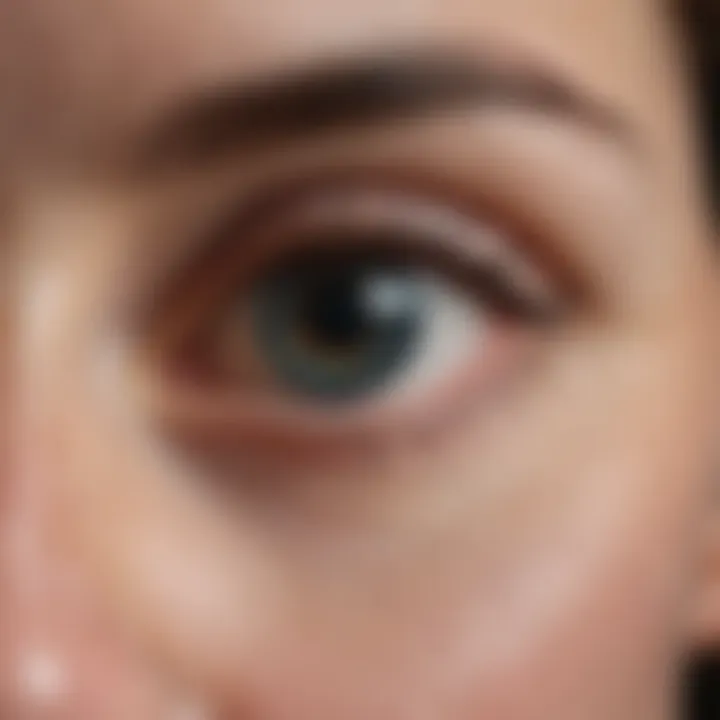Graves' Disease and Eye Pressure: A Comprehensive Guide


Intro
Graves' disease is an autoimmune disorder that primarily affects the thyroid gland, but its effects can extend beyond the neck. One of the notable manifestations involves the eyes, leading to a condition known as Graves' ophthalmopathy. In this context, elevated eye pressure becomes a relevant topic, as it can significantly impact ocular health and the overall well-being of individuals living with this condition.
Understanding the relationship between Graves' disease and eye pressure is essential for healthcare professionals, patients, and caregivers alike. This exploration dives into the mechanisms that link thyroid hormones with ocular changes, providing insight into symptoms, diagnostic processes, and effective treatment strategies that ensure optimal eye care.
Research Context
Background and Rationale
Graves' disease affects millions around the world, with varying degrees of severity. Thyroid hormones play a crucial role in regulating metabolism, but their influence extends to many body systems, including the eyes. When the immune system mistakenly attacks the thyroid gland, it leads to overproduction of these hormones, causing a cascade of biological effects. This condition impacts several ocular structures, potentially raising intraocular pressure and exacerbating existing eye conditions.
The rationale for delving into the connection between Graves' disease and elevated eye pressure stems from the need to better understand how thyroid dysfunction can lead to lasting ocular complications. Awareness of these connections can foster improved patient management and outcomes, making this a significant area of study.
Literature Review
A growing body of literature highlights the relationship between thyroid hormones and ocular health. Several studies reveal that individuals with Graves' disease may experience increased intraocular pressure. For example, research published in journals such as "Thyroid" and "Ophthalmology" indicates that abnormal thyroid hormone levels can lead to alterations in the output of eye fluid and changes in vessel dynamics, which are critical in maintaining pressure balance within the eye.
Graves' ophthalmopathy is associated with inflammatory processes that can lead to swelling behind the eyes, which might push on the optic nerve and other structures, further complicating intraocular pressure regulation.
In light of these insights, ongoing research aims to unravel further the complexities of this relationship, examining how different treatments might help in controlling elevated eye pressure among affected patients. The current literature suggests that comprehensive ocular assessments alongside standard thyroid function tests should be routinely integrated into patient care protocols.
By exploring the interplay between Graves' disease and eye pressure, we can not only enhance our understanding but also contribute to the development of targeted strategies for managing these patients effectively.
Understanding Graves' Disease
Graves' disease stands out as a significant autoimmune disorder, often intertwining with various bodily functions and systems. Its complex interactions, particularly concerning ocular health, underscore the importance of comprehensively understanding this condition. In the context of eye pressure, the role of Graves' disease becomes increasingly profound. As we uncover its nuances, practitioners and patients alike can grasp the implications of heightened eye pressure linked with thyroid dysfunction and the associated ocular manifestations.
Definition and Overview
Graves' disease is primarily defined as an autoimmune hyperthyroid condition. It occurs when the immune system mistakenly attacks the thyroid gland, causing it to produce excess thyroid hormones. This overproduction leads to a range of symptoms that extend beyond simple metabolic disturbances.
Key characteristics of Graves' disease include:
- Goiter: An enlarged thyroid gland, visibly swelling the neck region.
- Hyperthyroidism: Elevated levels of thyroid hormones in the bloodstream.
- Ocular Symptoms: Notable are the eye issues, often including symptoms such as bulging eyes, dryness, and discomfort.
Understanding these components lays the groundwork for appreciating how Graves' disease can escalate eye-related complications, particularly the pressures exerted within the eye.
Pathophysiology
The pathophysiology of Graves' disease is intricate. It begins when the body’s immune system produces antibodies, specifically Thyroid Stimulating Immunoglobulins (TSIs), which mistakenly stimulate the thyroid gland. This aberration spurs an overproduction of hormones like thyroxine. Consequently, these elevated hormone levels can foster several systemic effects, including alterations within the ocular structures.
For instance, the excessive hormones can trigger inflammation in the muscles and tissues around the eyes, often leading to Graves' ophthalmopathy. Such changes can culminate in increased eye pressure due to swelling and the structural alterations in ocular anatomy.
"Understanding the underlying mechanisms of Graves' disease allows health care providers to better anticipate ocular complications and manage them effectively."
Epidemiology
The epidemiology of Graves' disease reveals its varied impact across different demographics. It's predominantly diagnosed in females, particularly those aged between 30 and 50. However, this does not exclude males or those in other age brackets from being affected. Certain populations also show a higher prevalence, often attributed to environmental and genetic factors.
Key epidemiological insights include:
- Prevalence: Approximately 1 in every 200 people may have Graves’ disease in the general population.
- Genetic Predisposition: Family history plays a significant role, with individuals having relatives with autoimmune disorders at a greater risk.
- Geographical Variation: Rates appear to be higher in specific regions, potentially due to differences in iodine consumption and other environmental influences.
Grasping these epidemiological patterns helps health professionals anticipate outbreaks and better establish management plans for affected individuals.
Thyroid Function in Graves' Disease
Understanding how thyroid function operates in the context of Graves' disease is pivotal for grasping the broader implications of this autoimmune disorder. The thyroid gland, crucial to the hormonal balance of the body, plays a significant role in regulating metabolism, heart rate, and overall energy levels. In Graves' disease, however, the usual function of this gland is thrown into disarray, primarily leading to hyperthyroidism. This aberration not only impacts systemic health but particularly the ocular system, underscoring the need for a thorough examination of thyroid function in this context.
Hyperthyroidism Mechanisms
Hyperthyroidism in Graves' disease is a result of excess thyroid hormones produced by an overstimulated thyroid gland. This condition stems from autoantibodies that bind to receptors on the thyroid, tricking it into producing more hormones than necessary. Essentially, these antibodies mimic thyroid-stimulating hormone (TSH), hijacking the gland's natural regulatory mechanisms.
This heightened secretion can have several effects on the body, including:
- Increased metabolism leading to weight loss
- An increased heart rate, which can be felt as palpitations
- Anxiety and nervousness as energy levels soar
- Muscle weakness, especially in the upper arms and thighs
From an ocular perspective, elevated levels of thyroid hormones can cause the muscles and tissues behind the eyes to swell, contributing to various eye problems. The increased ocular pressure can also be tied to mechanisms that go beyond mere inflammation, making understanding these hormonal interactions essential to managing the ocular symptoms often seen in Graves' patients.


Hormonal Impact on Ocular Structures
The influence of thyroid hormones on ocular structures can not be understated. The eye's anatomy is delicate and intricate, dependent on a finely tuned balance of various mechanisms. Hormones like thyroxine and triiodothyronine are crucial in maintaining such balances. In individuals with Graves' disease, the excess of these hormones gives rise to significant ocular manifestations.
Consider the following consequences of hormonal imbalance on the ocular system:
- Increased Eye Pressure: The swelling tissues can compress ocular structures leading to elevated pressure within the eye, a concerning situation for glaucoma.
- Protrusion of the Eye (Proptosis): The muscles and fat around the eye can expand, causing the eyes to bulge outward, often referred to as exophthalmos. This can have immediate effects on vision and appearance, affecting the patient's self-esteem.
- Diplopia (Double Vision): The muscle imbalance can lead to misalignment of the eyes, resulting in double vision. As a further complication, this can hinder daily activities and impair quality of life.
- Tissue Damage: Chronic exposure to heightened thyroid hormone levels can lead to degenerative changes in the eye tissues, sometimes resulting in long-term vision problems.
"Understanding thyroid function in Graves' disease isn’t merely academic; it lays the groundwork for effective treatment and comprehensive care of affected patients."
Given this, monitoring and managing thyroid levels is crucial, not just for metabolic stability but also for preserving eye health. \nIt highlights an essential interplay between systemic health and ocular well-being, making thyroid function a cornerstone of effective care strategies.
Ocular Manifestations of Graves' Disease
Graves' disease doesn't just stop at affecting the thyroid. It has a broader impact that ripples through various aspects of health, including ocular health. Understanding the ocular manifestations is crucial because the eyes can reveal underlying issues related to the autoimmune disorder. This section aims to highlight symptoms, particularly the ones that might go unnoticed but are essential for early detection and management.
Symptoms Overview
When one thinks of Graves' disease, physical symptoms may spring to mind, such a rapid heartbeat and weight loss. Yet, eye symptoms often take a back seat. Common ocular signs include:
- Eye discomfort or irritation
- Redness in the eyes
- Swelling of the tissues surrounding the eyes
- Light sensitivity
- Blurred or double vision
These symptoms are the result of inflammation and changes in the eye's tissues. Their significance shouldn't be minimized. It’s vital to catch these early on, as they can lead to secondary complications like vision loss if not addressed. A keen eye for these changes can make all the difference in managing the disease effectively.
Graves' Ophthalmopathy
Graves' ophthalmopathy, also known as thyroid eye disease, is a direct consequence of Graves' disease. It's the inflammation and swelling of the eye muscles and surrounding tissues. What’s particularly troubling about this condition is that it can develop even when thyroid hormone levels stabilize. This makes monitoring essential.
The most prominent features of Graves' ophthalmopathy can include:
- Protrusion of the eyeball (exophthalmos)
- Impaired eye movement leading to discomfort
- Dry eyes due to reduced tear production
- Potential for severe complications, including optic nerve damage
Management of Graves' ophthalmopathy often involves steroid therapy to reduce inflammation and improve symptoms. In severe cases, surgical intervention may be necessary. Understanding this condition enhances the overall comprehension of ocular issues linked to Graves' disease and underscores the need for a comprehensive approach to patient care.
Impact on Eye Pressure
The relationship between Graves' disease and ocular pressure is intricate and significant. Fluctuations in eye pressure can stem from the numerous physiological changes brought about by the disease. This warrants closer examination, particularly in two key areas:
Increased Eye Pressure
Increased eye pressure, or glaucoma when it's chronic, can be a byproduct of the structural changes that occur in Graves' disease. These changes can compress the optic nerve, leading to serious implications. High eye pressure is a pressing concern because it might not show symptoms until it’s quite advanced.
Key characteristics of increased eye pressure include:
- Potential for irreversible vision loss
- Increased difficulty in diagnosing until significant damage occurs
Recognizing the symptoms of elevated eye pressure adds another layer of preventative care for patients with Graves' disease. Regular check-ups and monitoring can help catch these issues early, allowing for timely intervention.
Mechanisms of Pressure Changes
Mechanisms of pressure changes in the context of Graves' disease often relate back to inflammation and swelling. The muscle swelling can impede normal drainage of fluid within the eye, paving the way for increased pressure. Moreover, changes in the thyroid hormone levels can alter the vascular makeup of the eye, contributing to these complex dynamics.
Recognizing these mechanisms can assist in guiding patient care and sharpening focus on early detection strategies. They also underscore the importance of collaboration between endocrinologists and ophthalmologists in managing patients holistically.
"Monitoring eye pressure is as vital as monitoring thyroid levels for individuals battling Graves' disease.”
Through emphasizing these ocular manifestations and their consequences, one may glean the significance of addressing both the systemic and local effects of Graves' disease. This understanding can inform better clinical practices, ensuring that physicians remain vigilant in assessing not just the thyroid, but also the health of the eyes.
Understanding Eye Pressure
Understanding eye pressure is absolutely crucial when dealing with Graves' disease due to its direct impact on ocular health. Elevated eye pressure, or intraocular pressure (IOP), can precipitate a variety of complications, including glaucoma, which is a leading cause of vision loss among individuals with this autoimmune disorder. As such, gaining a comprehensive grasp of how eye pressure is defined, measured, and interpreted, can pave the way for better clinical outcomes.
The relationship between Graves' disease and eye pressure is strongly intertwined with the anatomical and physiological changes that occur within the eye. Thyroid hormones influence not just metabolic pathways but also ocular tissues. With an increase in thyroid hormones, the body may experience alterations in vascular tone, inflammation, and connective tissue changes leading to the classic symptoms observed in Graves’ ophthalmopathy.
Definition and Measurement
Intraocular pressure refers to the fluid pressure within the eye, primarily maintained by the balance of aqueous humor production and drainage. The normal range of IOP typically falls between 10 and 21 mmHg (millimeters of mercury). It is vital to employ consistent methods of measuring eye pressure for reliable monitoring. The most common technique used is the tonometry test, which can be performed non-invasively.
- Applanation Tonometry: This method involves flattening a small area of the cornea to ascertain pressure levels. It's widely accepted for its accuracy.
- Non-contact Tonometry: Often referred to as "air puff" tonometry, this technique uses a puff of air to measure eye pressure without touching the surface. It might be less accurate but is convenient for routine screenings.
Understanding the methodology behind these measurements can better inform clinicians and patients alike about fluctuations in IOP, especially in the context of Graves' disease.


Normal Versus Elevated Eye Pressure
Differentiating normal eye pressure from elevated levels is crucial in the context of Graves' disease. An eye pressure measured above the normal threshold can suggest potential complications. Factors contributing to elevated IOP in patients with Graves’ disease can range from:
- Swelling of the ocular muscles: This is a hallmark in Graves' ophthalmopathy.
- Increased vascular permeability: Thyroid hormones can lead to such changes, augmenting intraocular pressure.
- Reduced venous drainage: That often occurs due to muscle enlargement, necessitating vigilance in monitoring eye pressure.
Patients with consistently high IOP should be categorized for further evaluation. Looking out for indications such as headaches, blurred vision, or halos around lights might warrant a more comprehensive approach:
- Regular eye check-ups
- Imaging studies to observe structural changes
- Medications aimed at controlling both Graves’ disease and its ocular manifestations
"Elevated eye pressure is a window to potential future complications; recognizing this can spell the difference between sight and sightlessness."
Overall, knowledge about eye pressure isn't just academic; it's a vital aspect of managing an autoimmune condition that can change the lives of those who live with it.
Diagnostic Approaches
Understanding the diagnostic approaches related to Graves' disease is indispensable for managing eye pressure and ocular health effectively. Accurate diagnosis not only paves the way for suitable interventions but also assists in monitoring the progression of the disease. The importance of this section lies in the integration of clinical evaluation, imaging studies, and eye pressure monitoring, which together contribute to a comprehensive care strategy.
Clinical Evaluation
In the realm of diagnosing Graves' disease, clinical evaluation stands as the first line of defense. This evaluation encompasses a thorough medical history, along with a detailed physical examination focusing on ocular and thyroid health. Physicians often inquire about symptoms such as eye bulging, redness, or vision changes, which could signal complications arising from hyperthyroidism.
The evaluation also includes assessing Thyroid Stimulating Hormone (TSH) levels and antibodies such as Thyroid Peroxidase Antibodies (TPO). These tests are crucial because they provide insights into thyroid function, which is a common disruption in Graves' disease. Additionally, a meticulous eye examination may involve checking for signs of Graves' ophthalmopathy, which is critical in understanding how thyroid imbalance affects ocular structures.
Imaging Studies
Once clinical evaluation points toward ocular involvement, imaging studies become essential to visualize and assess the extent of the disease's impact. Common imaging techniques include computed tomography (CT) scans and magnetic resonance imaging (MRI), which can reveal structural changes in the eye socket and surrounding tissues. These studies help in identifying the volume of orbital fat, muscle enlargement, and any associated complications.
Imaging studies can provide a detailed snapshot of ocular anatomy and aid physicians in differentiating between Graves' ophthalmopathy and other possible causes of eye-related symptoms. The precision of imaging ensures that treatment plans are tailored to individual conditions, promoting better patient outcomes.
Monitoring Eye Pressure
Another crucial aspect of managing Graves' disease lies in the monitoring of eye pressure. Routine assessments of intraocular pressure (IOP) help track any fluctuations that may arise due to changes in thyroid hormone levels or the structural alterations in the eye. Elevated eye pressure can lead to glaucoma, a serious condition that, if left unchecked, might result in irreversible vision loss.
Monitoring involves utilizing tonometry, a method that measures IOP and indicates if any abnormal elevation is present. Such monitoring should ideally be part of regular follow-ups, especially for patients experiencing significant ocular symptoms. By integrating eye pressure assessments into the overall management plan, clinicians can promptly address any emerging complications and adjust treatment strategies accordingly.
"Effective diagnostics and vigilant monitoring can enhance the quality of life for those affected by Graves' disease, preventing severe ocular consequences."
In summary, the diagnostic approaches serve as the backbone of managing the complex interplay between Graves’ disease and elevated eye pressure. Through systematic clinical evaluation, advanced imaging techniques, and regular monitoring of eye pressure, healthcare providers can orchestrate a proactive strategy to improve patient outcomes. The interconnectivity of these elements reinforces the need for a well-rounded approach in clinical practice.
Therapeutic Strategies
The exploration of therapeutic strategies for Graves' disease is a vital component of addressing both the autoimmune condition itself and its ocular manifestations, including elevated eye pressure. Dealing with the dual impact on thyroid function and ocular health, these strategies aim to improve patient quality of life and manage complex symptoms.
Management of Graves' Disease
Effective management of Graves' disease typically encompasses pharmacological interventions, radioactive iodine therapy, or surgical options. The choice often depends on the severity of hyperthyroidism and the patient’s overall health. Medications like methimazole or propylthiouracil can help restrict thyroid hormone production. In some cases, patients may need to rely on radioactive iodine to ablate overactive thyroid tissue, while others may undergo thyroidectomy if other treatments are ineffective.
- Benefits
- Considerations
- Controls hormone levels swiftly.
- Reduces risks associated with long-term hyperthyroidism.
- Side effects from medications can include rash or liver issues.
- Radioactive iodine can cause hypothyroidism, necessitating hormone replacement.
Keeping the thyroid levels stable is crucial, as fluctuations can exacerbate ocular symptoms. This management also contributes indirectly to regulating intraocular pressure since thyroid hormones play a significant role in ocular health.
Addressing Ocular Symptoms
The ocular symptoms arising from Graves' disease require targeted interventions that may include the use of corticosteroids, radiotherapy, and in more severe cases, surgical decompression. Corticosteroids can reduce swelling and inflammation around the eyes, while radiotherapy can help target the tissues affected by Graves' ophthalmopathy. Surgical options may be explored for those experiencing significant pressure or vision loss.
In particular, managing eye pressure is tantamount, as elevated pressures can lead to further complications, including glaucoma. Some common strategies include:
- Lubricating Eye Drops
- Surgical Options for Eye Decompression
- Regular Follow-up
- Alleviate dryness and irritation.
- Relieve pressure on ocular structures.
- Monitoring ocular health to adjust therapeutic approaches as needed.


These interventions aim to alleviate symptoms, preserve vision, and ensure the best possible quality of life for patients grappling with the ocular challenges of Graves' disease.
Long-term Monitoring and Follow-up
Long-term monitoring is essential in managing Graves' disease and its ocular impacts effectively. Regular follow-ups with healthcare providers allow for timely adjustments in treatment strategies and facilitate close observation of any changes in eye health.
- Importance of Monitoring
- Components of Follow-up Care
- Early detection of complications, such as increased eye pressure or vision changes.
- Ensures treatments remain effective and safe over time.
- Periodic eye examinations to assess pressure and symptoms.
- Blood tests to monitor thyroid hormone levels.
Maintaining an ongoing dialogue with both endocrinologists and ophthalmologists allows for a holistic approach. It creates a safety net for patients to manage both the systemic and ocular elements of Graves' disease, ultimately striving for more favorable outcomes.
In summary, therapeutic strategies for Graves' disease encompass a spectrum of treatments that address both thyroid dysfunction and its subsequent ocular complications. With careful management of these interconnected issues, patients can find relief and improve their quality of life.
Psychosocial Considerations
Understanding the psychosocial aspects of Graves' disease is crucial for providing comprehensive patient care. This autoimmune disorder not only affects physical health but also significantly impacts emotional well-being and social dynamics. Addressing these facets can enhance overall treatment outcomes, supporting individuals in managing not just the disease but their quality of life as well.
Impact on Quality of Life
Graves' disease often brings with it a host of exhausting symptoms such as fatigue, anxiety, and ocular issues, which can leave individuals feeling overwhelmed. These side effects can lead to a diminished quality of life. Patients may grapple with feelings of isolation, anxiety, or low self-esteem due to the visible symptoms, particularly in terms of eye changes due to Graves' ophthalmopathy. As symptoms fluctuate, so does a person’s ability to engage in daily activities, creating a cycle of frustration and withdrawal.
Graves' disease can also affect relationships. Whether it's the burden of explaining the disease to friends and family or the physical changes impacting self-image, patients may encounter difficulties in maintaining their social connections. For instance, someone might feel reluctant to attend gatherings if they're having a particularly tough day with their symptoms, leading to increased feelings of isolation. Being aware of these emotional and social impacts can help caregivers and healthcare providers offer better support.
The importance of support networks cannot be overstated. Individuals must not only be informed about their diagnosis and treatment options but also encouraged to seek psychological support. Cognitive-behavioral strategies, support groups, and counseling can play a significant role in helping patients process their experiences and develop coping mechanisms.
Patient Support Resources
Effectively managing Graves' disease involves more than just addressing physiological symptoms. Here are some resources that can provide valuable support:
- Support Groups: Organizations such as the American Thyroid Association offer support networks where patients can connect with others facing similar challenges. These groups can foster a sense of community and reduce feelings of loneliness.
- Mental Health Services: Professional counseling services can help individuals navigate the emotional turmoil that may arise from living with a chronic condition. Therapists trained in chronic illness support can provide tools to cope with anxiety and stress associated with the disease.
- Educational Resources: Websites like Wikipedia provide comprehensive information on the disease, while Britannica offers articles that help patients and families understand the nuances of Graves' disease and its implications.
- Online Forums: Platforms like Reddit have communities where individuals can discuss their experiences, share advice, and offer each other support. This informal setting often allows for the sharing of personal stories that resonate with others, fostering understanding and empathy.
Utilizing these resources can make a world of difference. As patients gather information, realize they are not alone, and find supportive communities, they embark on a journey toward improved emotional and physical health.
Future Directions in Research
Research into Graves' disease, particularly in relation to elevated eye pressure and ocular manifestations, is crucial for advancing our understanding and treatment modalities. The complexities of this autoimmune condition intertwine with various factors—hormonal influences, genetic predispositions, and environmental triggers, all shaping the way we perceive and manage this illness.
Innovations in Treatment
Recent advancements have brought a light into the often murky waters of treating Graves' disease and its ocular effects. Novel approaches are essential not just for alleviating symptoms but also for addressing the underlying pathology. One such innovation involves the use of monoclonal antibodies which specifically target immune responses. These biologics might reduce inflammation and, consequently, lower eye pressure that is exacerbated by thyroid dysfunction.
Furthermore, a shift towards personalized medicine is underway. This involves tailoring treatment plans based on an individual’s specific genetic makeup and disease characteristics. For example:
- Antithyroid drugs might now be administered in conjunction with adjunct therapies.
- Radioactive iodine therapy has known efficacy but may evolve through enhanced delivery systems or adjunct treatments.
- Surgical options including orbital decompression are being refined to improve outcomes with less invasiveness.
"Ongoing clinical trials are focusing on how best to combine these therapies, aiming for a synergistic effect that could shift the landscape of care for these patients."
The exploration of new pharmacological agents, including potential neuroprotective therapies, might also pave the way for improved ocular health in Graves' sufferers. Such innovations are not merely academic; they have the potential to significantly enhance the quality of life for individuals grappling with the dual challenges of thyroid dysfunction and eye pressure problems.
Exploring Genetic Factors
Delving into the genetic underpinnings of Graves' disease opens a new frontier in our understanding of its pathophysiology. Research indicates that certain genetic markers may predispose individuals to develop Graves' disease and its associated eye complications. By identifying these markers, scientists hope to:
- Develop predictive tools that signal who is at higher risk for developing ocular manifestations.
- Identify targets for gene therapy, which could alter the disease course.
- Understand familial patterns to inform early diagnosis and treatment in at-risk groups.
The emerging field of epigenetics further complicates the picture. Environmental factors, such as stress or exposure to toxins, could interact with genetic predispositions, heightening the risk of ocular symptoms. For researchers, the focus can shift toward:
- Conducting large-scale genome-wide association studies.
- Investigating the interplay between genetics and immune system behavior in the context of thyroid disorders.
- Studying various ethnic groups to understand genetic variation and its impact on disease severity and manifestation.
These directions not only promise to deepen our knowledge but may also create pathways for revolutionary treatment options based on a more nuanced understanding of Graves' disease.
The road ahead in research is steep, but with it comes the potential for profound impacts on how we diagnose, treat, and support those afflicted by Graves' disease and its related ocular challenges.
The End
In wrapping up our exploration of Graves' disease and its relationship with elevated eye pressure, it’s crucial to reflect on the interconnected dynamics we've discussed. Graves' disease, as an autoimmune condition, fundamentally alters thyroid function, which, in turn, has significant implications for ocular health. The understanding of how thyroid hormones play a pivotal role in ocular manifestations — notably with increased eye pressure — is essential for clinicians and patients alike.
Summarizing Key Insights
To distill the focus of this article:
- Graves' disease can significantly elevate eye pressure due to the swelling of ocular muscles and tissues, which is symptomatic of Graves' ophthalmopathy.
- Monitoring eye pressure is not just about assessing discomfort; it’s about preventing potential long-term damage to the optic nerve that could arise due to sustained high tension within the eye.
- Diagnostic approaches, such as imaging and careful clinical evaluations, aid in understanding the degree to which Graves’ disease is affecting an individual’s ocular health.
- Managing the symptoms requires a comprehensive strategy that might include both medicinal and non-medicinal approaches, with an emphasis on follow-up care to ensure a better quality of life.
"A thorough grasp of the clinical implications of Graves' disease on ocular structures ultimately leads to improved patient outcomes."



